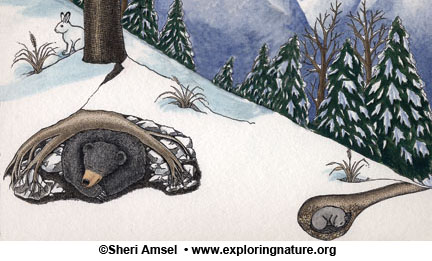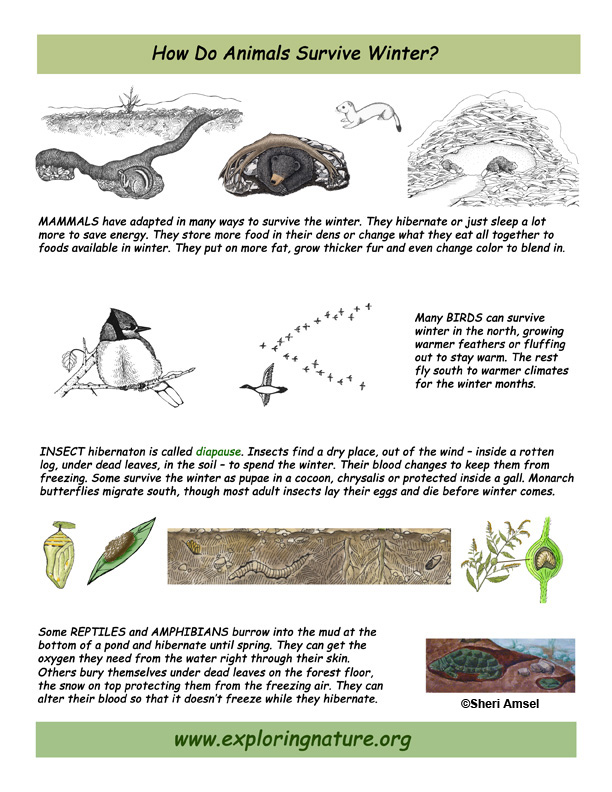


How Do Animals Survive Winter?
Age: K-6th grade
Objectives: Help students learn to think about adaptations and how they help animals survive.
Materials: Copies of How do Animals Survive the Winter? poster and How do Animals Survive the Winter? chart
Directions:
I. Ask questions and discuss hibernation with students.
II. Look at the Hibernation Poster together as a class.
III. Afterward have students fill out the Hibernation Chart.
I. Ask your students questions about hibernation and discuss the answers.
Mammals
Mammals have adapted in many ways to survive the cold winter months. One way to survive the winter is by hibernation. Hibernation is when an animal goes into a deep sleep. The heart beat and breathing slows down. The body cools down. They don’t eat food or drink water.
1. Why do animals hibernate? Animals use up their body’s fat much more slowly when they hibernate than if they were awake and moving around. In winter there is little or no food available. They have to put on a lot of extra weight in the fall, when the food is available, to have enough fat stored for winter.
2. How do animals know when to start hibernation?
Animals begin hibernating for two reasons. Some begin when the days grow shorter in the fall.
Some begin when the days get colder. If an animal waits to hibernate until it gets cold, it can keep eating until then. During a very mild winter, it might not have to hibernate at all.
3. Are all mammals that sleep a lot in winter hibernating?
There are different kinds of hibernation. Some animals are true hibernators. This means their body cools way down. They don’t move for days or weeks. It’s hard to wake an animal in true hibernation. This can be dangerous if a predator attacks. That’s why true hibernators find a safe den before they sleep. Some true hibernators are chipmunks, woodchucks, bats, turtles, frogs, toads, salamanders, and snakes. A woodchuck is the biggest true hibernator. It’s temperature drops from 98° to 40°. Its heartbeat slows from 80 beats per minute to just 4!
Some animals don’t really hibernate but go into a deep sleep called torpor. Torpor can last for a few days or just a few hours on a very cold night. Their body does cool off, but not as much as hibernators. In torpor an animal can wake up in case of danger. Only warm-blooded animals can use torpor to survive the winter. Animals that go into torpor are black bears, raccoons, skunks, some mice and birds. Black bears can sleep for 6 months. They don’t eat or drink. Females can give birth in their den during the winter.
4. Do animals just hibernate in cold climates?
Sometimes animals hibernate to survive hot, dry weather instead of cold. This kind of hibernation is called estivation.
A lot of animals survive the winter by staying active the whole time. They grow a layer of fat and warmer fur. The short-tailed weasel and the snowshoe hare adapt to their winter habitat by turning white to blend in with the snow. Other mammals that are active all winter are shrews, mink, voles, foxes, grey squirrels, and red squirrels.
5. What are some ways mammals that don’t hibernate stay alive all winter?
• Beavers and squirrels store lots of food they can eat all winter. Deer and rabbits search for food under the snow. Shrews, mink, weasels, fox, owls and hawks hunt all winter.
• White-tailed deer gather together into a deer yard sheltered by evergreen trees to wait out the coldest times.
• Many animals change what they eat in the winter. Shrews eat fruit, mushrooms, insects and small animals in the summer. In the winter, all they eat is animals.
Insects
6. What are some ways that insects survive the winter?
• Some insects also hibernate. Their hibernation is called, diapause. They start when the days get shorter. This starts on just about the same day every year, no matter what the temperature.
• Some moths and butterflies survive the winter in a cocoon or chrysalis. In the spring they hatch out as adults. Some stay in their caterpillar form, like wooly bears, and dig under dead leaves or the dirt.
• Some insects survive the winter as adults. They stay in a dry place, out of the wind, inside a rotten log, under dead leaves or burrowed into the soil. Their blood changes and keeps them from freezing. These include ladybugs, wasps, mourning cloak butterflies, and honey bees.
• Some insects dig into plant stems and form a big swelling called a gall. This keeps them safe from cold and snow until they dig out as adults in the spring. You may have seen these galls on plants in your yard.
• The Monarch butterfly migrates to warm climates for the winter.
• Most insects don’t survive the winter. They lay eggs in the ground or the bark of a tree and then they die. In the spring the eggs hatch and the cycle starts again.
Reptiles and Amphibians
7. What are some ways that reptiles and amphibians survive the winter?
• Cold-blooded animals, like reptiles and amphibians, also hibernate when the days grow shorter. They burrow into the mud at the bottom of their pond or lake. All winter they sleep and take oxygen into their skin from the water. They need the warmth of their environment to heat their bodies, so they must start hibernating on time. If they’re caught out on a freezing day, they will die.
• A few frogs like spring peepers, tree frogs and wood frogs spend the winter buried under dead leaves on the forest floor. Their blood changes so that they won’t freeze easily. Snow on top of the leaves also helps keep them from the freezing air. On the first warm day of spring, the peepers come out and start singing.
Birds
8. What are some ways that birds survive the winter?
• Most birds survive the winter by going south to warmer places. This is called migration.
• Yet some birds can stay north in the cold, like grouse, wild turkeys, chickadees, hawks, and owls. They grow warm winter feathers. What birds near you can be seen all winter?
• Grouse burrow into a snowdrift during cold spells and use the snow to protect them from the freezing air. This is called a snow roost.
Related Content:
Surviving Hibernation - It's a BEAR!
NGSS Disciplinary Core Ideas
LS2.C: Ecosystem Dynamics, Functioning, and Resilience
• When the environment changes in ways that affect a place’s physical characteristics, temperature, or availability of resources, some organisms survive and reproduce, others move to new locations, yet others move into the transformed environment, and some die. (secondary to 3-LS4-4)
LS4.A: Evidence of Common Ancestry and Diversity
• Some kinds of plants and animals that once lived on Earth are no longer found anywhere. (Note: moved from K-2) (3-LS4-1)
• Fossils provide evidence about the types of organisms that lived long ago and also about the nature of their environments. (3-LS4-1)
LS4.B: Natural Selection
• Sometimes the differences in characteristics between individuals of the same species provide advantages in surviving, finding mates, and reproducing. (3-LS4-2)
LS4.C: Adaptation
• For any particular environment, some kinds of organisms survive well, some survive less well, and some cannot survive at all. (3-LS4-3)
LS4.D: Biodiversity and Humans
• Populations live in a variety of habitats, and change in those habitats affects the organisms living there. (3-LS4-4)
Performance Expectations Students who demonstrate understanding can:
3-LS4-1. Analyze and interpret data from fossils to provide evidence of the organisms and the environments in which they lived long ago.
3-LS4-2. Use evidence to construct an explanation for how the variations in characteristics among individuals of the same species may provide advantages in surviving, finding mates, and reproducing.
3-LS4-3. Construct an argument with evidence that in a particular habitat some organisms can survive well, some survive less well, and some cannot survive at all.
3-LS4-4. Make a claim about the merit of a solution to a problem caused when the environment changes and the types of plants and animals that live there may change.*
When you research information you must cite the reference. Citing for websites is different from citing from books, magazines and periodicals. The style of citing shown here is from the MLA Style Citations (Modern Language Association).
When citing a WEBSITE the general format is as follows.
Author Last Name, First Name(s). "Title: Subtitle of Part of Web Page, if appropriate." Title: Subtitle: Section of Page if appropriate. Sponsoring/Publishing Agency, If Given. Additional significant descriptive information. Date of Electronic Publication or other Date, such as Last Updated. Day Month Year of access < URL >.
Amsel, Sheri. "How Do Animals Survive Winter? Hibernation, Migration, Adaptation!" Exploring Nature Educational Resource ©2005-2024. December 13, 2024
< http://www.exploringnature.org/db/view/How-Do-Animals-Survive-Winter-Hibernation-Migration-Adaptation >

